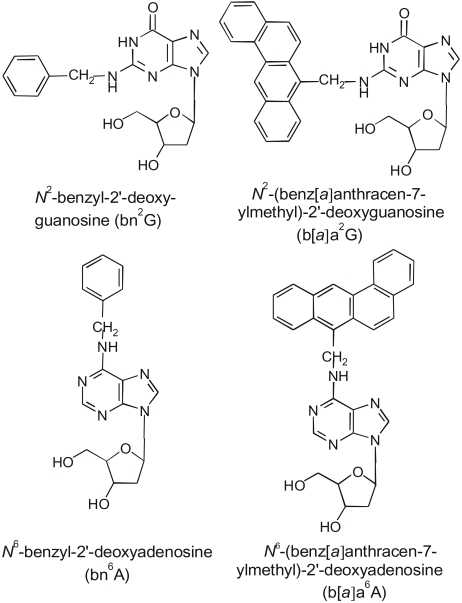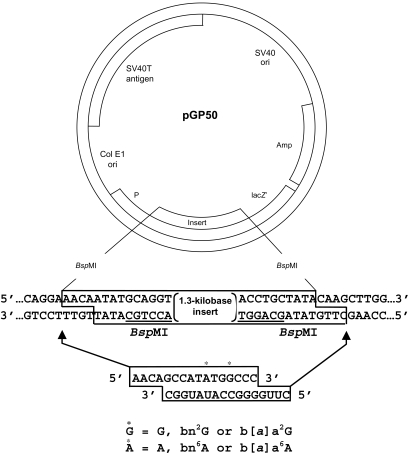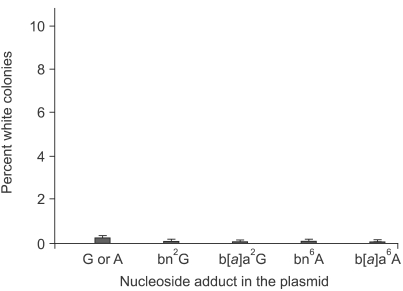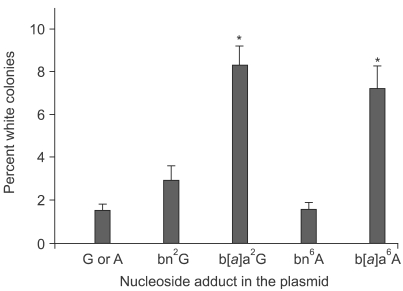Cancer Res Treat.
2004 Apr;36(2):151-156.
Site-Specific Mutagenesis in Human Cells by Bulky Exocyclic Amino-Substituted Guanine and Adenine Derivatives
- Affiliations
-
- 1Department of Clinical Pathology, and Bioindustry and Technology Research Institute, Kwangju Health College, Gwangju, Korea. kmoon@www.kjhc.ac.kr
Abstract
- PURPOSE
7-Bromomethylbenz[a]anthracene is a well- known mutagen and carcinogen. The aim of this study is to determine the mutagenic potency of its two major DNA adducts [N2-(benz[a]anthracen-7-ylmethyl)-2'-deoxyguanosine (b[a]a2G) and N6-(benz[a]anthracen-7- ylmethyl)-2'-deoxyadenosine (b[a]a6A)] and the simpler benzylated analogs [N2-benzyl-2'-deoxyguanosine (bn2G) and N6-benzyl-2'-deoxyadenosine (bn6A)] in Ad293 human cells and to compare to their mutagenicity in human cells and E. coli. MATERIALS AND METHODS: The shuttle vector pGP50 is capable of replicating in E. coli and human cells. Modified nucleotides were positioned in the plasmid pGP50 in a manner similar to pGP10 as described (8). Adenovirus transformed human embryonic kidney cells (line 293) were transfected with a shuttle vector containing an adduct. Two days later, the plasmids were recovered and treated with DpnI to remove unreplicated DNA. DH10B E. coli were transformed with the plasmids. Bacteria were cultured with the media containing X-gal, IPTG and ampicillin. Bacteria transformed by the plasmid with the adduct-induced mutation in the initiation codon of lacZ' form white colonies whereas bacteria transformed by the plasmid without mutation form blue colonies. RESULTS: In the human cell site-specific mutagenesis system, bn2G exhibited weak mutagenicity and bn6A was not mutagenic, although b[a]a2G or b[a]a6A produced 8% and 7% mutant colonies, respectively. At the site of the adduct, b[a]a2G induced the G--> T transversion mutation while b[a]a6A produced the A--> G transition mutation. CONCLUSION: These data indicate that bulkier b[a]a2G and b[a]a6A exhibit significantly greater mutagenicity in human cells than in E. coli.
Keyword
MeSH Terms
Figure
Reference
-
1. Moschel RC. Hemminki K, Dipple A, Shuker DEG, Kadlubar FF, Segerback , Bartsch H, editors. Reaction of aralkyl halides with nucleic acid components and DNA. DNA Adducts Identification and Biological Significance. IARC Scientific Publication No. 128. 1994. France: IARC, Lyon;p. 25–36.2. Basu AK, Essigmann JM. Site-specifically modified oligodeoxynucleotides as probes for the structural and biological effects of DNA-damaging agents. Chem Res Toxicol. 1988; 1:1–18. PMID: 2979705.
Article3. Pauly GT, Powers M, Pei GK, Moschel RC. Synthesis and properties of H-ras DNA sequences containing O6-substituted 2'-deoxyguanosine residues at the first, second, or both positions of codon 12. Chem Res Toxicol. 1988; 1:391–397. PMID: 2979756.4. Dipple A, Brookes P, Mackintosh DS, Rayman MP. Reaction of 7-bromomethylbenz[a]anthracene with nucleic acids, polynucleotides, and nucleosides. Biochemistry. 1971; 10:4323–4330. PMID: 5126943.5. Dipple A, Slade TA. Structure and activity in chemical carcinogenesis: Studies of variously substituted 7-bromomethylbenz[a]anthracenes. Eur J Cancer. 1971; 7:473–476. PMID: 5159876.6. Rayman MP, Dipple A. Structure and activity in chemical carcinogenesis. Comparison of the reactions of 7-bromomethylbenz[a]anthracene and 7-bromomethyl-12-methylbenz[a] anthracene with deoxyribonucleic acid in vitro. Biochemistry. 1973; 12:1202–1207. PMID: 4734662.7. Dipple A, Slade TA. Structure and activity in chemical carcinogenesis: Reactivity and carcinogenicity of 7-bromomethylbenz[a]anthracene and 7-bromomethyl-12-methylbenz[a]anthracene. Eur J Cancer. 1970; 6:417–423. PMID: 5500708.8. Moon KY. Site-specific mutagenesis in Escherichia coli by bulky exocyclic amino-substituted guanine and adenine derivatives in double-stranded or gapped plasmids. Cancer Res Treat. 2003; 35:75–80.9. Pandya GA, Moriya M. 1, N6-Ethenodeoxyadenosine, a DNA adducts highly mutagenic in mammalian cells. Biochemistry. 1996; 35:11487–11492. PMID: 8784204.10. Moriya M, Zhang W, Johnson F, Grollman AP. Mutagenic potency of exocyclic DNA adducts: Marked differences between Escherichia coli and simian kidney cells. Proc Natl Acad Sci. 1994; 91:11899–11903. PMID: 7991554.11. Moriya M, Spiegel S, Fernandes A, Amin S, Liu T, Geacintov N, Grollman AP. Fidelity of translesional synthesis past benzo[a]pyrene diol epoxide-2'-deoxyguanosine DNA adducts: Marked effects of host cell, sequence context, and chirality. Biochemistry. 1996; 35:16646–16651. PMID: 8988000.12. Moon KY, Kim YS. Synthesis and characterization of oligonucleotides containing site-specific bulky N2-aralkylated guanines and N6-aralkylated adenines. Arch Pharm Res. 2000; 23:139–146. PMID: 10836739.13. Pauly GT, Hughes SH, Moschel RC. A Sectored colony assay for monitoring mutagenesis by specific carcinogen-DNA adducts in Escherichia coli. Biochemistry. 1991; 30:11700–11706. PMID: 1751489.14. Graham FL, Smiley J, Russell WC, Nairn R. Characteristics of a human cell line transformed by DNA from human adenovirus type 5. J Gen Virol. 1977; 36:59–72. PMID: 886304.
Article15. Pei GK, Moschel RC. Aralkylation of 2'-deoxyguanosine: Medium effects on sites of reaction with 7-(bromomethyl) benz[a]anthracene. Chem Res Toxicol. 1990; 3:292–295. PMID: 2133074.16. Pauly GT, Hughes SH, Moschel RC. Mutagenesis in Escherichia coli by three O6-substituted guanines in double-stranded or gapped plasmids. Biochemistry. 1995; 34:8924–8930. PMID: 7612634.17. Pauly GT, Hughes SH, Moschel RC. Comparison of mutagenesis by O6-methyl-and O6-ethylguanine and O4-methylthymine in Escherichia coli using double-stranded and gapped plasmids. Carcinogenesis. 1998; 19:457–461. PMID: 9525280.18. Pauly GT, Hughes SH, Moschel RC. Response of repaircompetent and repair-deficient Escherichia coli to three O6-substituted guanines and involvement of methyl-directed mismatch repair in the processing of O6-methylguanine residues. Biochemistry. 1994; 33:9169–9177. PMID: 8049220.19. Pauly GT, Peterson LA, Moschel RC. Mutagenesis by O6-[4-oxo-4-(3-pyridyl)butyl]guanine in Escherichia coli and human cells. Chem Res Toxicol. 2002; 15:165–169. PMID: 11849042.20. Page JE, Ross HL, Bigger CA, Dipple A. Mutagenic specificities and adduct distributions for 7-(bromomethyl)benz[a]anthracenes. Carcinogenesis. 1996; 17:283–288. PMID: 8625451.21. Rodriguez H, Loechler EL. Mutational specificity of the (+)-anti-diol epoxide of benzo[a]pyrene in a sup F gene of an Escherichia coli plasmid: DNA sequence context influences hotspots, mutagenic specificity and the extent of SOS enhancement of mutagenesis. Carcinogenesis. 1993; 14:373–383. PMID: 8453713.22. Litinski V, Chenna A, Sagi J, Singer B. Sequence context is an important determinant in the mutagenic potential of 1,N6-ethenodeoxyadenosine (εA): formation of εA basepairs and elongation in defined templates. Carcinogenesis. 1997; 18:1609–1615. PMID: 9276637.23. Ponten I, Sayer JM, Pilcher AS, Yagi H, Kumar S, Jerina DM, Dipple A. Sequence context effects on mutational properties of cis-opened benzo[c]phenanthrene diol epoxide-deoxyadenosine adducts in site-specific mutation studies. Biochemistry. 1999; 38:1144–1152. PMID: 9894012.24. Khalili H, Zhang FJ, Harvey RG, Dipple A. Mutagenicity of benzo[a]pyrene-deoxyadenosine adducts in a sequence context derived from the p53 gene. Mutat Res. 2000; 465:39–44. PMID: 10708967.
- Full Text Links
- Actions
-
Cited
- CITED
-
- Close
- Share
- Similar articles
-
- Site-Specific Mutagenesis in Escherichia coli by Bulky Exocyclic Amino-Substituted Guanine and Adenine Derivatives in Double-Stranded or Gapped Plasmids
- Human leukocyte antigen epitope definition using site-directed mutagenesis
- Expression and Characterization of the Human Immunodeficiency Virus Type 1 Mutant Envelope Glycoproteins in Mammalian Cells
- SLC26A4 Mutations in Korean Population
- Immunohistochemical Localization of Guanine Aminohydrolase, a Protein Identical with Novel Protein p51-nedasin, and SAP 102 in the Rat Retina






